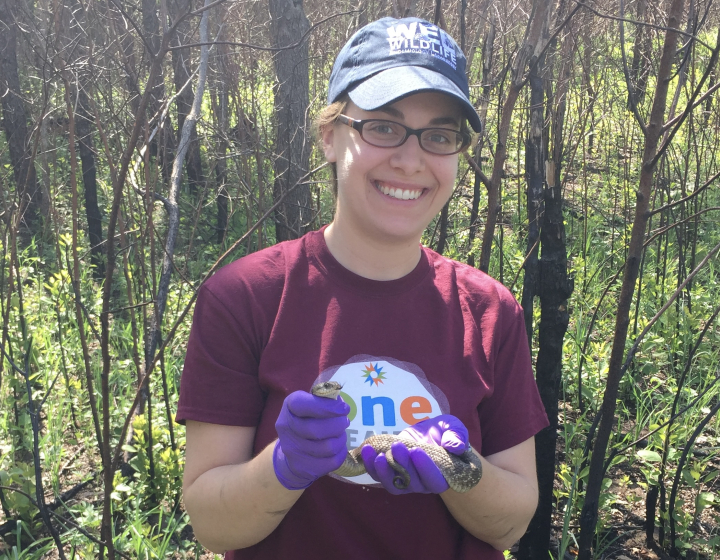New faculty profile: Dr. Anushka Dongre
The Cornell University College of Veterinary Medicine (CVM) has recently welcomed many new faculty members to our academic departments, each one bringing a unique set of skills and experience that enriches our college every day. In this Q&A series, you'll get to know their interests, expertise and more.
Dr. Anushka Dongre, assistant professor in the Department of Biomedical Sciences
Q: What has been your academic/career path leading up to Cornell?
I pursued my Ph.D. in Dr. Barbara A. Osborne’s laboratory at the University of Massachusetts-Amherst, where I studied the role of Notch signaling in T-cells. For my postdoctoral training, I was keen to apply my skills as an immunologist to better understand cancer progression. This led me to join Dr. Robert A. Weinberg’s laboratory, at the Whitehead Institute for Biomedical Research and the Massachusetts Institute of Technology (MIT) in Cambridge, Massachusetts. I then joined Cornell as an assistant professor in the Department of Biomedical Sciences. I also hold an adjunct appointment in the Department of Microbiology and Immunology.
Q: What drew you to CVM?
I was particularly drawn by the interdisciplinary research opportunities and the highly collaborative and welcoming environment at CVM.
Q: What is your scientific area of expertise?
I work at the interface of cancer biology and immunology. I am specifically interested in understanding how the residence of breast cancer cells in distinct phenotypic states, termed epithelial-mesenchymal plasticity, drives resistance to anti-tumor immunity and immune checkpoint blockade therapies.
Q: What drew you into this area? Any specific experiences, mentors, influences that helped guide you?
I was fascinated by immunology as a graduate student in Dr. Barbara Osborne’s lab, where I studied Notch signaling in T-cells. This experience prepared me to apply my knowledge as an immunologist during my postdoctoral work with Dr. Robert A. Weinberg, where I studied how the epithelial-mesenchymal transition, a process that facilitates metastasis, drives the resistance of breast tumors to anti-tumor immunity. Here, I also got the opportunity to familiarize myself with cancer biology, which at the time was a completely new field to me. Both these experiences have led me to integrate cancer biology and immunology into my own research. I consider myself very fortunate to have had supportive mentors who gave me the intellectual freedom to pursue the questions I was most passionate about and shaped the course of my career.
Q: What past professional work are you most proud of and why?
I am most proud of establishing murine models of epithelial and more-mesenchymal breast tumors and using them to demonstrate that epithelial tumors respond to immune checkpoint blockade therapy, while their more-mesenchymal counterparts are resistant. Moreover, a minority population of more-mesenchymal cells can protect their epithelial neighbors residing within the same tumor from immune attack. This is particularly important as most human breast tumors contain minority fractions of more-mesenchymal cells, which can drive resistance of the tumor as a whole to immunotherapy.
Q: What about your research work are you most excited for/proud of and why?
I am proud of a recent finding where we could sensitize highly refractory, more-mesenchymal cancer cells to immunotherapy by targeting the expression of certain paracrine factors. I am most excited about this finding because of its translational potential, particularly in the context of heterogenous breast tumors that harbor populations of more-mesenchymal cancer cells.
Q: What impacts or applications do you hope to see your work have on the world, human health?
A large fraction of breast cancer patients are unresponsive to immune checkpoint blockade therapies and the underlying reasons for this unresponsiveness are still not well defined. I am very hopeful about the prospect of using epithelial-mesenchymal plasticity as a predictive criterion. I am also very excited about potentially targeting this program to enhance the efficacy of immunotherapies for breast cancer.
Q: What scientific questions are you looking to answer next/areas you plan to explore?
I will continue to study the molecular mechanisms by which more-mesenchymal breast cancer cells exert immunosuppressive, cross-protective effects and drive resistance to immunotherapies.
Q: What’s something most people don’t know about you?
I enjoy painting as a hobby.
Q: What’s the best part of being a scientist?
The thrill of discovery! The endless opportunities to learn and acquire new skills. I also derive immense joy and satisfaction from mentoring students and watching them succeed as scientists. This is probably, for me, the most fulfilling aspect of being a scientist.
Q: What’s the most challenging part?
Scientific research is a slow process. Behind each successful experiment are numerous failed attempts. The ability to persist through these moments of frustration, is one of the most challenging parts of being a research scientist.
Q: What are the benefits of working at CVM? At Cornell?
CVM and Cornell provide an unparalleled scientific research environment, access to cutting edge technologies, and a highly supportive and collaborative working environment. I love coming to work every day and I am very grateful to be a part of this community.




